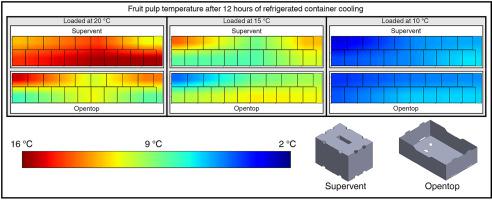当前位置:
X-MOL 学术
›
Biosyst. Eng.
›
论文详情
Our official English website, www.x-mol.net, welcomes your
feedback! (Note: you will need to create a separate account there.)
Cooling of ambient-loaded citrus in refrigerated containers: What impacts do packaging and loading temperature have?
Biosystems Engineering ( IF 4.4 ) Pub Date : 2021-01-01 , DOI: 10.1016/j.biosystemseng.2020.11.002 T.M. Berry , T. Defraeye , W. Wu , M.G. Sibiya , J. North , P.J.R. Cronje
Biosystems Engineering ( IF 4.4 ) Pub Date : 2021-01-01 , DOI: 10.1016/j.biosystemseng.2020.11.002 T.M. Berry , T. Defraeye , W. Wu , M.G. Sibiya , J. North , P.J.R. Cronje

|
South Africa is the second-largest exporter of fresh citrus fruit, which is shipped to various distant markets for extended durations. Rising production quantities and increasingly more stringent phytosanitary requirements have placed considerable pressure on the logistics chain and the availability of precooling facilities. One solution to this challenge has been the application of ambient loading when using high-cube refrigerated containers, whereby fruit are cooled in-transit during shipping, instead of on-site by precooling. This study explored the effect of two package designs and the benefits of first partially precooling fruit prior to loading in shipping containers. Performance parameters was evaluated based on cooling rate and cooling uniformity of fruit within the spatial domain of the container. Containers loaded with Supervent and Opentop cartons had a mean cooling period (from initial to 4 °C) of 2.0 and 1.6 days, respectively. However, the study identified a high variability in cooling rate between and within individual containers. This was attributed to the presence of unpredictable gaps around the pallet stacks, which are formed during loading. These unique ensembles of gaps substantially influenced how cooling airflow was delivered throughout the container. The results thus showed package design is not a primary influencer of cooling performance. Partially precooling fruit to 10 °C, before loading, reduced susceptibility to chilling injury and decreased the presence of hot spots throughout the containers, so reducing the cooling variability within the shipment. This work highlighted the complex thermodynamic processes within fully loaded refrigerated containers, which should be characterised in future research.
中文翻译:

在冷藏容器中冷却常温装载的柑橘:包装和装载温度有什么影响?
南非是新鲜柑橘类水果的第二大出口国,这些水果长期运往各个遥远的市场。不断增加的产量和日益严格的植物检疫要求给物流链和预冷设施的可用性带来了相当大的压力。应对这一挑战的一个解决方案是在使用高立方体冷藏集装箱时应用环境载荷,即水果在运输过程中在运输途中冷却,而不是通过预冷在现场进行冷却。本研究探讨了两种包装设计的效果以及在装入集装箱之前先对水果进行部分预冷的好处。基于容器空间域内水果的冷却速率和冷却均匀性来评估性能参数。装有 Supervent 和 Opentop 纸箱的容器的平均冷却时间(从初始到 4 °C)分别为 2.0 天和 1.6 天。然而,该研究发现单个容器之间和内部的冷却速度存在很大差异。这是由于托盘堆周围存在不可预测的间隙,这是在装载过程中形成的。这些独特的间隙组合极大地影响了整个容器中冷却气流的输送方式。因此,结果表明封装设计不是冷却性能的主要影响因素。在装载前将水果部分预冷至 10 °C,降低了对冷害的敏感性,并减少了整个集装箱中热点的存在,从而减少了装运中的冷却变化。
更新日期:2021-01-01
中文翻译:

在冷藏容器中冷却常温装载的柑橘:包装和装载温度有什么影响?
南非是新鲜柑橘类水果的第二大出口国,这些水果长期运往各个遥远的市场。不断增加的产量和日益严格的植物检疫要求给物流链和预冷设施的可用性带来了相当大的压力。应对这一挑战的一个解决方案是在使用高立方体冷藏集装箱时应用环境载荷,即水果在运输过程中在运输途中冷却,而不是通过预冷在现场进行冷却。本研究探讨了两种包装设计的效果以及在装入集装箱之前先对水果进行部分预冷的好处。基于容器空间域内水果的冷却速率和冷却均匀性来评估性能参数。装有 Supervent 和 Opentop 纸箱的容器的平均冷却时间(从初始到 4 °C)分别为 2.0 天和 1.6 天。然而,该研究发现单个容器之间和内部的冷却速度存在很大差异。这是由于托盘堆周围存在不可预测的间隙,这是在装载过程中形成的。这些独特的间隙组合极大地影响了整个容器中冷却气流的输送方式。因此,结果表明封装设计不是冷却性能的主要影响因素。在装载前将水果部分预冷至 10 °C,降低了对冷害的敏感性,并减少了整个集装箱中热点的存在,从而减少了装运中的冷却变化。











































 京公网安备 11010802027423号
京公网安备 11010802027423号